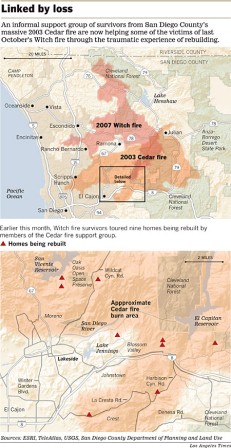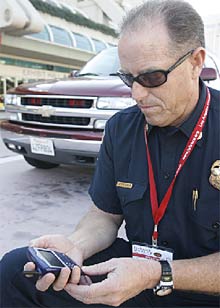
There is a very interesting story in the Los Angeles Times about an informal group that had one thing in common….. they all lost their homes during the 2003 Cedar Fire east of San Diego and helped each other through the extremely complex process of rebuilding. The group had an influx of new members following the Witch fire of last October. The article is long, but worth reading.
Here is an excerpt from the story:
LAKESIDE, CALIF. — As firefighters battled flames and evacuated northeastern San Diego County in October, a group of Cedar fire survivors did what they wished someone had done for them five years ago.
They headed out on fire watch.David Kassel, 53, the group’s founder, drove over to Billi-Jo Swanson’s horse ranch with his fire hose to help wet down brush.
Steven Murray, 54, rode his motorcycle above San Vicente Dam to investigate reports of flames climbing the hill.
Then Kassel and Valentine “Val” Lance, 67, motored out to keep tabs on Wildcat Canyon Road, a major thoroughfare to Ramona that firefighters kept closing. The pair advised residents whether to stay home or evacuate.
That kind of expertise was hard won. Five years ago, they met as shell-shocked strangers, burned out by the Cedar fire — the state’s worst in 75 years — which consumed 273,000 acres, killed 15 people and left more than 3,000 homeless.
Survivors convened on Thursday nights in the Lakeside storefront of Maine Avenue Tax Service. They were academics and ranchers, Democrats and Republicans, exurban neighbors who wouldn’t have said more than hello at Starbucks before the fire.
Week by week, they helped each other through illnesses and other crises. The group grew from 10 to 50, adding an online list of many more. Some rebuilt bigger and better, and dropped out of the group. Others faltered and still haven’t rebuilt.
Then the wildfires returned to San Diego County. New fire victims began turning up at meetings, adrift and alone, and the dozen remaining regulars realized that they had a new mission.





